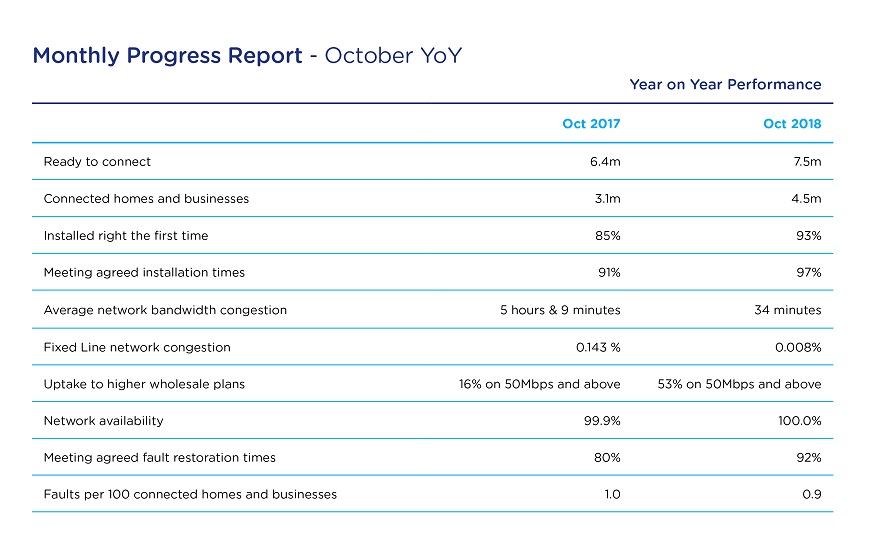NBN Co demonstrates continued momentum
53 per cent growth in company revenue and 48 per cent increase in activations
Summary of progress for the first quarter of FY2019 ended 30 September 2018:
- Strong performance across monthly progress report metrics.
- 7.3 million premises ready to connect – an additional 310,000 premises for the three months.
- Almost 4.4 million activations – an additional 339,000 premises for the three months.
- $620 million in total revenue – up 53 per cent on the comparative
NBN Co – the company building and operating Australia’s broadband network – has grown total revenue to $620 million for the first quarter of fiscal year 2019 and continued its progress on network construction and activations.
Reporting its progress for the three months to 30 September 2018, the company declared 7.3 million premises ready to connect to services over the nbn™ broadband access network and 8.6 million premises ready for service. These figures represent more than 60 per cent of homes and businesses now able to order a service and approximately three quarters of total network construction now complete.
The growth in footprint helped increase total network activations to almost 4.4 million premises, an additional 339,000 homes and businesses for the first quarter and a 48 per cent increase on the comparative period.
Revenue reached $620 million for the three months, an increase of 53 per cent compared to 30 September 2017, and supported by an ARPU of $44.
The company’s performance for the first quarter of fiscal year 2019 demonstrates continued momentum towards its goal to complete the build and connect eight million homes and businesses to services over the nbn™ access network by 2020.
Ongoing commitment to end user customer experience
NBN Co today released its latest monthly progress report for October, demonstrating a continued focus on helping to improve end user customer experience for those connected to the nbn™ access network.¹
The company’s latest report shows that 53 per cent of homes and businesses are now connected to 50 Mbps wholesale download speed tier plans or above, compared to just 16 per cent 12 months ago². Average bandwidth congestion across the nbn™ access network (excluding Sky Muster) has eased from highs of more than five hours a year ago to 34 minutes on average per week, per premises, at the end of October, despite some fluctuations during this period.³
Over the month of October, 93 per cent of installations are being completed right the first time and 92 per cent of service faults are being rectified within agreed timeframes with retail service providers.⁴ These improvements are due to NBN Co’s focus on continuous process innovation and improvement, education and training of the field workforce.

*Figures are rounded to the nearest whole number
Commentary on company performance
NBN Co CEO Stephen Rue said: “We are entering the biggest deployment and activation years of the nbn build and these results demonstrate our ability to scale and deliver.
“Central to our continued progress and performance are our strong relationships with delivery partners and retail service providers. Industry collaboration has helped us scale network deployment quickly and make substantial improvements to end-user experience.
“53 per cent of all homes and businesses are now on a 50 Mbps wholesale download speed or higher, with 70 per cent of new customers opting for these higher speed plans each month. We know our pricing decisions last year are having the impact we intended, that is, to help provide a good experience for homes and businesses using the network.
“We are confident we’ll continue to deliver in partnership with the industry, meeting our Corporate Plan targets for the 2019 financial year and driving towards network completion by 2020.”
Notes for editor:
¹ NBN Co’s monthly progress report is designed to give Australians a clear understanding of the ways in which the company is taking action to improve customer experience. The metrics used relate to services NBN Co delivers to phone or internet providers and the physical connection of homes and businesses to nbn™ infrastructure. The metrics do not cover services supplied by providers to end users. Metrics are based on averages, summaries and simplifications – end user experiences vary. For important information on the metrics and their descriptions please visit nbn.com.au/updates
² Uptake of 50Mbps wholesale speed plans and higher - this metric includes plans based on the 25-50 Mbps wholesale download speed tier.
³ Average network bandwidth congestion – calculated across all bandwidth purchased by all phone and internet providers across the whole network and excludes nbn™ Sky Muster™ services. While bandwidth congestion is caused by the level of provisioning of capacity by the phone and internet providers, there are also other types of congestion which may occur on the nbn™ access network.
⁴ Right first time installations – typically excludes end-user cancellations, end-user or service provider initiated reschedules and other things outside of NBN Co’s control such as bad weather. This measure covers the installation of equipment that does not require more than one appointment. It does not cover successful connections to a plan over the nbn™ access network through a phone and internet provider.
Meeting agreed fault restoration times – measures individual service faults, not network related faults which are tracked separately. The measure also excludes faults not related to the nbn™ access network. The agreed service levels vary depending on the location of the premises, and are different for the nbn™ Sky Muster™ Satellite network. The Wholesale Broadband Agreement includes detailed rules for defining "nbn faults" and measuring nbn™ access network performance. This does not include Priority Assistance Faults or Enhanced Faults.
Media enquiries
Jace Armstrong
Phone: 0431 987 599
Email: jacearmstrong@nbnco.com.au
Sharon Chang
Phone: 0447 582 337
Email: sharonchang@
nbnco.com.au

